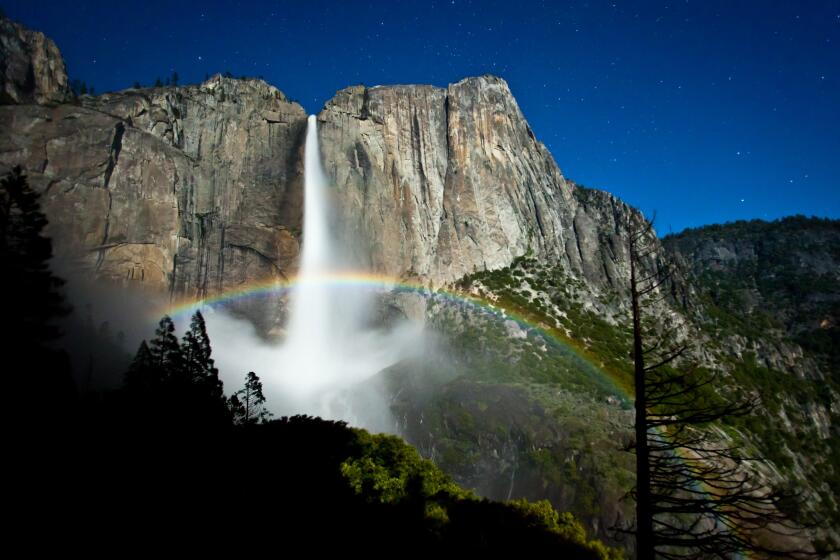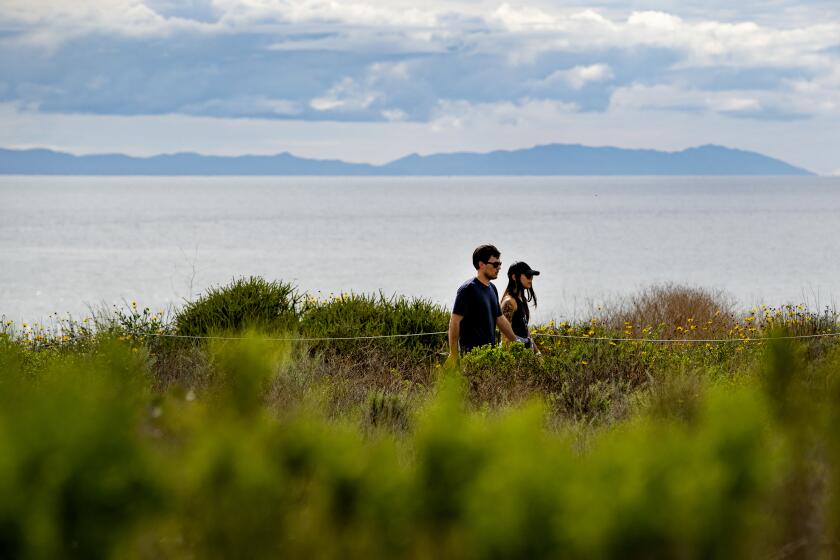Exploring Andalusia’s String of Pearls
As our car raced down the steep cobblestone streets of Jimena de la Frontera, my daughter began to shriek.
“I’m sorry for anything I ever said!” Becca screamed. “We’re gonna die!”
It certainly seemed that way. Half a block ahead, without warning, the road turned into a staircase, and we were headed straight for it. The bars at the top of the steps would slow our rental car, but they wouldn’t stop it.
I swerved to the right, prayed as we squeezed through a narrow passage, then shot down another narrow street and out into a lovely plaza lined with benches, strolling Spaniards and a row of orange trees below a pink domed tower. The crenelated Moorish castle we had just explored, mostly in ruins but for the walls and a glorious arch, loomed over the white-walled village.
We slowed and stopped and caught our breath.
Which is what one does in these small towns in Andalusia, the southernmost region of Spain. Northern Andalusia has the wonderful cities of Seville, Granada and Cordoba. The southern coast, along the Mediterranean between Gibraltar and Malaga, is, in most cases, grossly overdeveloped.
This mountainous region between the two, called the Serrania de Ronda, is a wonderful tangle of gorges, cork forests, vast rocky peaks and startlingly white villages that glow in the distance like a cluster of pearls.
Much of the charm of this area is not about visiting museums but about participating in the flow of daily life. Each day we slowed down, as though the quicksilver of modern life were being replaced by the sweet dessert wine made in nearby Manilva.
My mother lives in this part of the world, about a mile below the white-walled village of Casares, up in the hills behind the beach town of Estepona. An American, she came here 30 years ago, fell in love with the area and never left.
I bring Becca here every year. We revisit some towns (we never miss Ronda), but each year we try to explore at least one “new” white village.
That’s how we happened last August to be in Jimena, a place we will remember if only because we didn’t end up as a memorial plaque on one of its whitewashed walls.
Parts of Andalusia were inhabited 50,000 years ago. From 25,000 BC on, humans left traces of their presence in cave paintings, which you can still see on Route C339 near Ronda at the Cueva la Pileta.
Later residents built fortifications and other structures high on promontories that gave them a natural defense from marauders. When the Romans invaded in 200 BC with a well-organized army, they constructed their forts on those same pinnacles. The Moors swept in from Africa in 711, used Roman stones to build their own arches and castles and stayed for 800 years, creating an enduring cultural duality. A quarter of all Spanish words, for instance, have Arabic origins. Throughout the region, Arab arches stand next to Gothic towers. Bejeweled statues of the Virgin are carried through narrow streets past trickling fountains that reflect the Arab reverence for water, all reminders of the dual Andalusian personality.
Today, tourists often are the invaders. They head for the cities or the beaches. And in doing so, they miss the story of Andalusia that’s told through these pueblos blancos, white villages, where bulls can still roam unfettered and the people remain true to their roots.
The white village of Casares, one of the most beautiful in Spain, is a heart-shuddering mile-and-a-half hike up along a cobblestone Roman path from my mother’s home. Looking down on the village from the old Moorish fortress built about 1,000 years ago, Casares appears to be a Cubist labyrinth, all white slanted walls and tiled roofs. Once you’re inside the maze, the view closes down to narrow passages, a strip of blazing blue sky above, white walls on both sides.
Within a few days of our arrival, Becca and I went to Casares for dinner. From the rooftop restaurant of La Bodeguita, we watched the moon rise over the nearby Sierra Bermeja while the plaza below buzzed with life.
We drank chilled gazpacho and ate pork chops smothered in garlic and wild thyme, chicken croquettes, onion and tomato salad and crusty local bread.
I nodded hello to a group of Brits drinking tinto de verano (red wine and sweet soda water with lemon), a refreshing end to a long, hot day.
Like Southern California, this region is warm and dry from May to October. The hills bleach golden, and the free-range cattle and goats depend on the few year-round streams that fringe the river bottoms with a strip of emerald.
On a brilliantly sunny day, we took an aimless drive north over the hills on a tiny, winding back road. We ended up at Cortes de la Frontera, a village two river valleys over from Casares.
At one point, our way was blocked by a man riding a spirited horse. He wore the traditional Andalusian costume--tight, gray-striped flannel pants, a red sash at his waist, and a flat-brimmed black felt hat. A sen~orita rode behind him in a flamenco dress that trailed over the horse’s back side.
They were joining a parade through the town, part of the local feria that once celebrated the end of harvest. Like the caballero, many were in traditional dress, and best of all, there wasn’t a tourist in sight.
Casares celebrated its feria a few days later. Everyone drank beer and manzanilla, a type of very dry sherry that’s consumed as cold as possible. And many revelers strolled from bar to bar eating raciones, snacks that are larger than tapas but not a full meal. A family can order navajas, or razor clams, in one restaurant, then three hours later share a plateful of octopus and roasted squash in another bar.
At 2 in the morning, the plazas were in full swing. Partners danced the Sevillana, a graceful, arm-waving affair in which they draw in toward each other, then whirl away. The wailing music drifted up toward the ruins of the castle, and the clapping of many hands sounded like the clatter of horses on cobblestones.
I n the last few years, rural tourism in this area has been, for the first time, sponsored by the government. A simple state-run hotel now rents typical village homes inside the walls of the splendid castle town of Castellar de la Frontera, just up off the coast of nearby Algeciras. Tiny white houses are tucked inside the walls of the castle, creating a honeycomb of narrow alleys smothered in bougainvillea and geraniums.
Gaucin, another nearby white village a few miles up the Rio Genal from Casares, has a wonderful new hotel and restaurant called La Fructuosa, the result of a government loan. The owners rebuilt an old wine-press operation and turned it into an elegant inn with rustic character. The restaurant decor is part Andalusian patio, with honeysuckle and fountains, and part old wine press, with 4-foot-thick chestnut beams framing the dining room. The sleeping rooms above have a view all the way to the great hump of stone that is Gibraltar and across the Mediterranean to the mountains of Morocco.
At night, as we dined, a swirl of stars rose over the mountains behind Gaucin. I ate a first course of oranges, olives and red cabbage drenched in a local olive oil so green, it seemed to have been pressed that afternoon; next came a delicious fresh goat cheese grilled with rosemary. The squid entree was too chewy, but the dessert, a surprisingly fruity avocado mousse, was divine. And so was the view down the steep valley, so clear I could see the 22 miles to the coast.
Becca’s favorite day excursion from Casares is the mountain town of Ronda. (She loves the shoe stores along the pedestrian walkway near the bullring.) The road twists down from Casares across a shallow river, then vaults uphill to Gaucin, where we always stop for a quick cafe con leche at a venta, one of the roadside restaurants that serve simple but delicious meals. After coffee, we took local road A377 north out of Gaucin. As it sweeps along a ridge top, the hillside to the right plunges straight down 2,000 feet to the Rio Genal.
After 90 minutes of mind-boggling curves, Ronda appears. It once was the center of a Moorish kingdom ruled by Abu Nur, and it’s still a town of palaces and churches, at least in the old historic section, a hybrid of Moorish and Christian style called Mudejar.
At the Palacio Mondragon, intricate tiles line the walls and garden fountain. The palace has a typically Moorish-style enclosed courtyard, a carved wood ceiling and a breathtaking view from its parapets over the countryside.
The nearby Catholic church, Santa Maria la Mayor, has a minaret and a Muslim prayer niche within its Gothic superstructure.
In the Casa del Rey Moro, one of the many Moorish-style palaces that line the cliffs of the river gorge, a tunnel leads 365 steps down to the river, from which servants once fetched water. All three of these buildings are open to the public.
For Becca and me, no visit to southern Spain and the white villages is complete without at least one day on the beach. At the Casares beach we ate at a chiringuito, a seasonal seaside shack that serves fabulous grilled sardines and shrimp pil-pil (tiny shrimp served in sizzling in olive oil). We swam and rested well into the evening before heading back up the hill to Casares. At this time of year, the local grapes of Manilva were ripe, and we stopped at a roadside shack to buy a kilo of so-sweet-they’re-almost-fermented grapes, a local goat cheese and a loaf of just-baked bread--like Andalusia, simple but very satisfying.
(BEGIN TEXT OF INFOBOX / INFOGRAPHIC)
GUIDEBOOK
Andalusia’s White-Walled Towns
Getting there: From LAX, Swissair and Lufthansa fly with one change of planes to Malaga, Spain. Restricted round-trip air fares begin at $1,116.
Where to stay: Just off the coast is the San Roque Club, 11360 San Roque, Cadiz; telephone 011-34-956-61-30-30, fax 011-34-956-61-30-13. It offers access to three golf courses. Deluxe rooms with breakfast start at about $170. Greens fees for guests are about $63.
In Ronda, Parador de Ronda, Plaza de Espan~a, S/N 29400, Ronda; tel. 011-34-952-87-75-00, fax 011-34-952-87-81-88, Internet https://www.castles.org/hotels/spain/spain20.htm. Doubles start at about $94.
Across the street is the newly remodeled Hotel Don Miguel, Villanueva 8, Ronda; tel. 011-34-952-87-77-22, fax 011-34-952-87-83-77. Ask for a room with a view. About $60 double.
Also try Hostal Anon, Calle Consuelo 36, Jimena de la Frontera; tel. 011-34-956-64-01-13, fax 011-34-956-64-11-10. Rooms are about $40.
In Gaucin, Hotel Casablanca is housed in an old mill. Doubles are about $60. Also in Gaucin is La Fructuosa, a superb restaurant that offers several guest rooms; doubles about $72. Tel. 011-34-952-15-10-72, fax 011-34-952-15-15-80.
Where to eat: In Casares, rooftop La Bodeguita, Plaza de Espan~a 15, local tel. 89-40-36. A great place from which to observe village life.
The Venta Victoria (no phone) on the road to Casares has great views and simple but good food. On the beach is a great chiringuito called La Sal; tel. 89-07-89.
For more information: Tourist Office of Spain, 8383 Wilshire Blvd., Suite 956, Beverly Hills, CA 90211; tel. (323) 658-7188 or (323) 658-7192, fax (323) 658-1061, Internet https://www.okspain.org.
Sign up for The Wild
We’ll help you find the best places to hike, bike and run, as well as the perfect silent spots for meditation and yoga.
You may occasionally receive promotional content from the Los Angeles Times.



